The following information is summarized from the Northern Colorado Plateau Network monitoring plan, published in 2004. Some details may have changed.
Park History and Purpose
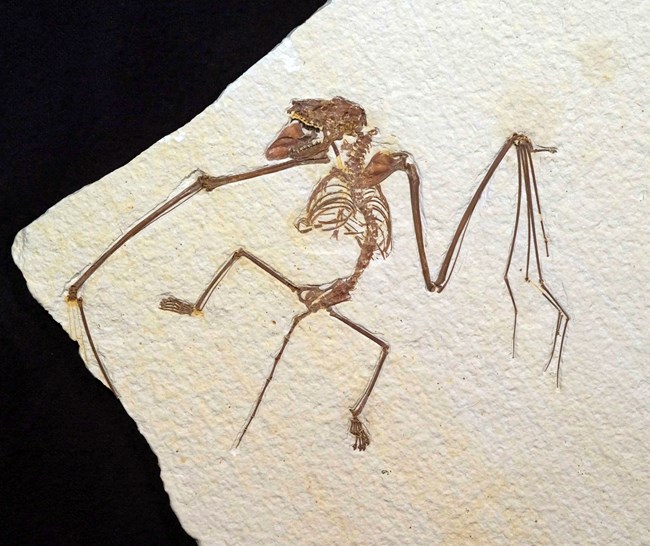
NPS
According to the enabling legislation, approved October 23, 1972, Fossil Butte National Monument was created “… to preserve for the benefit and enjoyment of present and future generations outstanding paleontological sites and related geological phenomena, and to provide for the display and interpretation of scientific specimens…”
The enabling legislation also stipulated, in Section 4 (a), that “[f]or a period of ten years, and for not more than ten years thereafter if extended by the Secretary, the continuation of existing uses of Federal lands and water within the monument for grazing and stock watering may be permitted if the Secretary finds that such uses will not conflict with public use, interpretation, or administration of the monument, Provided, That the use of lands within the monument for stock driveways shall continue in perpetuity at such places where this use will not conflict with administration of the monument.” The enabling legislation further provided in Section 4 (b), “[u]pon termination of the uses set forth in subsection (a) of this section, the Secretary of the Interior is authorized to provide for the disposition and use of water surplus to the needs of the monument, to a point or points outside the boundaries of the monument.”
Grazing was discontinued after the1989 growing season. One remote spring was developed to provide water beyond the boundary for livestock and wildlife.
Today, the monument continues to protect and preserve portions of the Green River and Wasatch formations, which contain a unique fossilized assemblage of organisms that once lived in or around Fossil Lake, an ancient lake of Eocene age. Many other clues to the environment of Fossil Lake and its environs are also preserved in the stratigraphic units of the Wasatch and Green River formations.
Location
Fossil Butte National Monument is located in southwest Wyoming near U.S. Highway 30, approximately 21 kilometers (13 miles) west of the town of Kemmerer and 161 kilometers (100 miles) south of Jackson.
Elevation
The lowest topographic point is approximately 2,018 meters (6,620 feet) above mean sea level, where Chicken Creek crosses the boundary near the main entrance. The summit of the Bull Pen, near the northern boundary, is the highest point. The Bull Pen summit is 2,464 meters (8,084 feet) above sea level.
Size
3,318 hectares (8,198 acres)
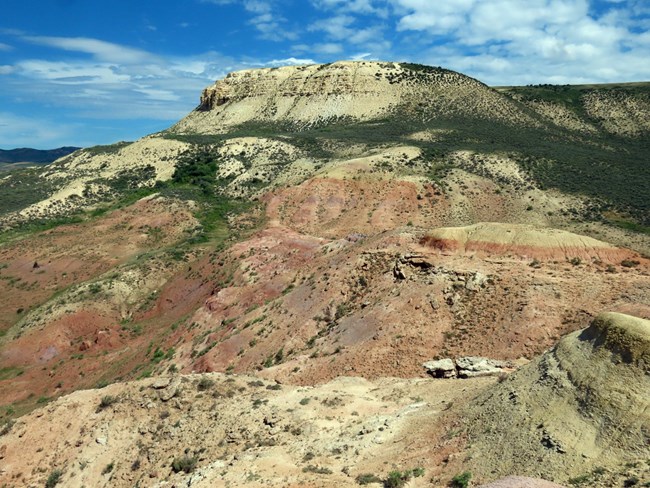
NPS/John Collins
General Description
The boundary encompasses land dominated by sagebrush steppe vegetation. The area is considered to be high, cold desert. Precipitation averages between 229 and 305 millimeters (9 and 12 inches) per year, most of it falling as snow. The mean frost-free period is 59 days. Winters can be extremely cold, with temperatures occasionally falling to -30°F or less. Summer nights are cool with the temperature frequently dropping below 50°F. During the day, summer temperatures rarely exceed 90°F.
The uppermost, nearly white stratum of the Green River Formation is exposed along the steep slopes of Cundick Ridge and along the slopes of Fossil Butte. The Wasatch Formation underlies, overlies, and intermingles with the Green River Formation, but to the untrained eye, outcroppings of its colorful dull red, pink, lavender, purple, yellow, and gray strata appear to be scattered at random through the park.
Small, deep, steep-sided valleys, some named by park staff, dissect the highlands. Millet Canyon, on the west side, lies between Rubey Point and the western extent of Cundick Ridge. Murder Hill, Middle Canyon, and Moosebones Canyon are on the east side. Ridges projecting eastward from the highlands in the northern half separate these valleys.Fossil Butte and Cundick Ridge rise to the east above Chicken Creek, an interrupted, intermittent stream with ephemeral tributaries, which drains approximately two-thirds of the land. Only the uppermost few hundred yards of Chicken Creek are perennial. Generally, the stream flows throughout its entire length only for a few months during late spring and early summer, when it conveys snowmelt and spring storm runoff. Slopes on the eastern side of the watershed are steep (7.5–20%). Below 2,073 meters (6,800 feet), the gradient of Chicken Creek is 1–2%. The lower reaches of Chicken Creek are severely eroded. Historically, railroad construction reduced the stream’s base level, which brought about channel incision in the lower portions of the watershed.
Plants and Animals
Visitors may encounter a wide range of native and nonnative plant and animal species throughout the site.
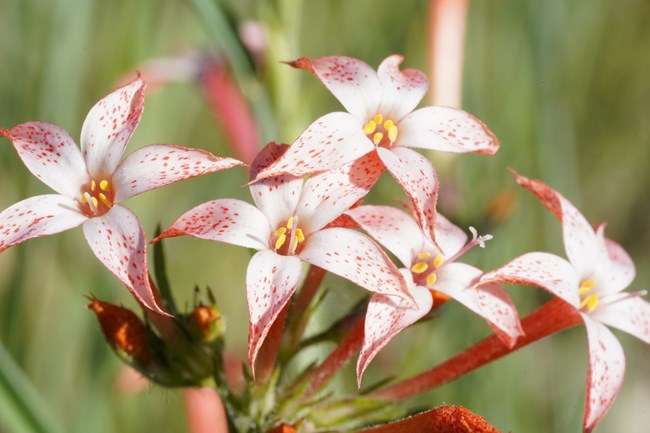
NPS/John Collins
Flora
In 1984, the following vegetation types were mapped: aquatic (rooted in water), aspen, barren, alkali sagebrush (low sage), basin big sagebrush, cottonwood, disturbed, grass/forb, mixed timber, mountain big sagebrush, mountain shrub, saline, wet meadow, and willow. The distribution of these types is controlled primarily by soil moisture and edaphic factors, but some types, like the barren type occurring on ridgetops, are also wind-influenced. Vegetation was mapped in 1984 on aerial photographs that contained some distortion caused by camera angle. The vegetation patterns were transferred by hand to 1:24,000 scale USGS topographic maps. Editor’s note: Current information on vegetation mapping at the monument can be found on the network’s Vegetation Classification and Mapping page.
Three sagebrush communities dominate the landscape. The basin big sagebrush type occurs below approximately 2,195 meters (7,200 feet) on sites with deep, loamy, fertile soils. It is dominated by basin big sagebrush (Artemisia tridentata ssp. tridentata), bluegrasses (Poa spp.), and wheatgrasses (Elymus spp.). The mountain big sagebrush type, dominated by mountain big sagebrush (A. tridentata ssp. vaseyana), occupies sites above 2,195 meters (7,200 feet) having characteristics similar to sites supporting the basin big sagebrush type. Various wheatgrasses, bluegrasses, and forbs are present in the understory. The alkali sagebrush type, dominated by low sagebrush (A. arbuscula), occurs on deep, clay soils at all elevations. This type occurs on soils with higher salinity and alkalinity than the other sagebrush types.
The aspen type occurs on mesic sites in these scenarios: along the base of Cundick Ridge and in valleys below springs and seeps, below ridges where the prevailing west wind causes snow accumulation during winters with average (or more) snowfall and wind, and on north-facing slopes that remain in shadow throughout much of the day. The aspen type is dominated by aspen trees (Populus tremuloides).
Mixed timber occurs primarily on steep north-facing and east-facing slopes where soils are shallow and often calcareous. Limber pine (Pinus flexilis), Douglas-fir (Pseudotsuga menziesii), and aspen dominate the mixed timber type. Mountain shrub occurs on sites similar to those that support mixed timber. It appears to be a successional precursor to the mixed timber type because it sometimes dominates burned areas that once supported stands of aspen and mixed timber types. Also, conifer seedlings can be seen in many areas currently supporting mountain shrub communities. Mountain mahogany (Cercocarpus montanus), Utah serviceberry (Amelanchier utahensis), and mountain snowberry (Symphoricarpos oreophilus) are the dominant shrubs in the mountain shrub type.
The grass/forb type is dominated by Sandberg bluegrass (Poa sandbergii), but Indian ricegrass (Stipa hymenoides) and wheatgrasses are also present. Common forbs include stemless goldenweed (Haplopappus acaulis), Hood’s phlox (Phlox hoodii), and starveling milkvetch (Astragalus jejunus). This type thrives on drier sites in shallow soil, such as rocky ridges. The grass/forb type also exists where fire destroyed shrubby vegetation types. Rock outcrops and barren, windswept ridges were mapped as the barren type.
Some areas are totally devoid of vegetation. Others support widely spaced cushion plants, grasses, and forbs, such as tufted twinpod (Physaria condensata).The wet meadow type is dominated by Baltic rush (Juncus balticus) and sedge species (Carex spp.). Many other forb and grass species are present in the wet meadow community. Silver sagebrush (Artemisia cana) dominates drier sites, and willow species (Salix spp.) sometimes occur in more mesic sites. The cottonwood and willow vegetation types occupy, at most, a few acres where seepage or artesian springs keep the soil wet. The saline type is dominated by black greasewood (Sarcobatus vermiculatus) and Gardner’s saltbush (Atriplex gardneri).
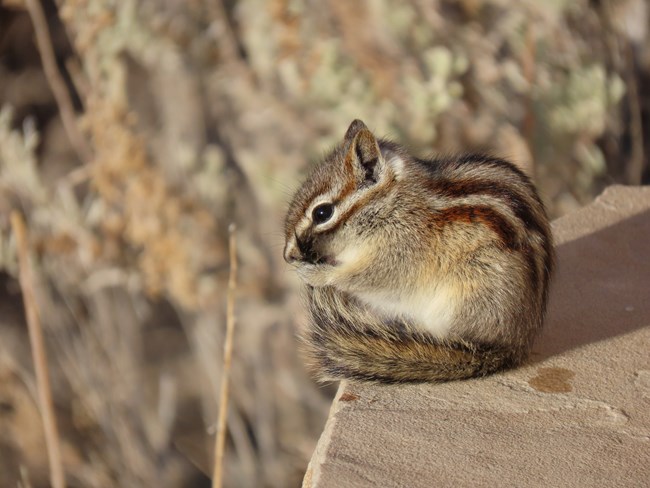
NPS/John Collins
Fauna
More than 200 species of birds, mammals, snakes, and amphibians have been documented. Probably only the list of large mammals approaches the 90% level of completeness. Reptiles and amphibians are uncommon; only five species have been documented. One or two fish species enter during the brief period Chicken Creek is flowing. Fry and fingerlings have been observed in ephemeral pools near the boundary, but they have not been identified.
Pronghorn, jackrabbits, least chipmunks, and Richardson's ground squirrels are probably the mammals most often seen. A variety of songbirds are present, and kestrels, northern harriers, red-tailed hawks, and golden eagles are common summer residents.
Ungulates
The monument was grazed by domestic livestock for approximately 100 years. In 1990, livestock grazing was discontinued. The effect of livestock grazing remains unquantified, but researchers have made the following generalizations:
- The monument was grazed during most of the year, primarily by sheep prior to 1973;
- Improper placement of mineral blocks concentrated cattle on riparian areas;
- Most recently, the grazing allotment was 1,166 animal unit months (AUMs);
- Since livestock movement was uncontrolled prior to 1977, grazing may have exceeded the allotment of 1,166 AUMs;
- Grazing probably decreased the amount of perennial grasses;
- Grazing probably increased the number and variety of annual plants; and
- Grazing probably increased soil compaction and accelerated soil erosion.
Mule deer (Odocoileus hemionus) and a few moose (Alces alces) reside throughout the year. Elk are seen occasionally in summer, and a few may reside throughout the year. More mule deer migrate onto the monument during the fall and early winter. They remain until late spring, leaving as land north of the monument becomes snow-free. A herd of more than 100 elk (Cervus elaphus) spends part of the winter on the monument. Elk use appears to be increasing, and this could become a problem. Pronghorn are commonly seen from late spring into late fall or early winter. Pronghorn usually migrate to wintering areas outside the monument as soon as the snowpack accumulates in late fall or early winter.Mule deer, elk, and moose appear to be overbrowsing some shrub communities, especially the mountain shrub type and the few stands of willow and red osier dogwood (Cornus sericea). Based on the type and amount of scat observed, deer and moose use mountain shrub habitat more than elk. Moose are responsible for damage observed in willow and red osier dogwood.
Riparian and Aquatic Habitats
Riparian and aquatic habitats of limited size occur at Fossil Butte National Monument. There are sufficient perennial sources in and around the monument that large native ungulates move about quite freely. Their distribution is probably affected to some degree by water availability, but to what extent remains uncertain. Domestic livestock, especially cattle, stay near water, and they damage riparian and aquatic plant communities. The extent of this impact was never quantified. In a wet year, standing and flowing water covers no more than 1–2% of the monument (a rough estimate). Three valleys (Millet Canyon, Murder Hill Canyon, and Moosebones Canyon) and the headwater area of Chicken Creek immediately downstream of Spring #1 have had, or currently have, small populations of beaver. At present, only Millet Canyon and the area below Spring #1 have significant beaver activity. Most of the aspen near water in the other beaver activity areas have been felled and, at most, only one or two beaver live in those areas. The majority of aquatic habitat was created by beaver, but land slumping has created a few additional ephemeral ponds that support aquatic vegetation during part of the year.
Even where there is beaver activity and a perennial source of water, the water supply is insufficient to maintain all the ponds throughout summer, even in the wettest years. The majority of slump ponds also dry up by mid-summer or earlier. These ponds support several species of emergent vegetation, such as the common cattail (Typha latifolia), but they do not support a rich variety of submergent aquatic vegetation.
Ephemeral ponds may actually be detrimental to the monument’s amphibian population, including the northern leopard frog, which is a species of management concern because ponds frequently dry up before the larval amphibians can live out of water. Even when ponds do not completely dry, low water levels have been observed to concentrate tadpoles, making them easy targets for predatory birds.In the past, several locations supported beaver where there is no water today. Intermittent springs probably supplied water to these locations. They are expected to flow again if above-normal precipitation occurs for several consecutive years.
Unique Features and Species of Special Concern
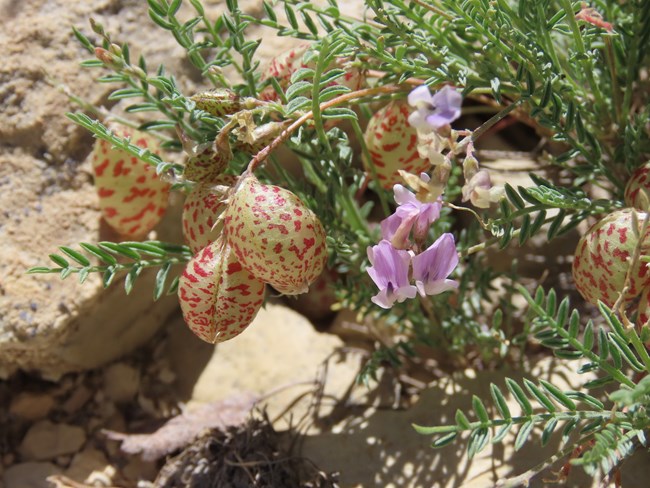
NPS/John Collins
Plants
None of the vegetation types are believed to be unique. However, management has special concerns regarding several vegetation types. Tufted twinpod (Physaria condensata) and starveling milkvetch (Astragalus jejunus Wats. var. jejunus) are considered imperiled globally and within Wyoming because distribution is limited, but they are not on the U.S. Fish and Wildlife Service’s endangered list. The largest populations are in the barren and grass/forb plant communities. Dorn’s twinpod (Physaria dornii), which resembles tufted twinpod, was considered for inclusion in the endangered species list in 1994. Dorn’s twinpod occurs immediately west of the monument, but its occurrence inside the park remains unproven.
Large ungulates appear to be over-utilizing the mountain shrub community at many localities. Mountain mahogany and antelope bitterbrush (Purshia tridentata), in particular, have many “clubbed” branches because most new growth has been removed by browsing for many years. Shrubs in this vegetation type already are, or are becoming, senescent. Ungulate over-browsing in the mountain shrub community is a management concern.Invasive exotic plants are a management concern. Presently, at least 53 exotic plant species have been discovered growing inside the boundary. Introduced plants account for nearly 10% of species. Some exotic species are designated “noxious weeds,” which must be controlled by landowners. Presently, Fossil Butte National Monument controls Canada thistle (Cirsium arvense), bull thistle (C. vulgare), musk thistle (Carduus nutans), mullein (Verbascum thapsus), common burdock (Arctium minus), spotted knapweed (Centaurea maculosa), perennial sowthistle (Sonchus uliginosus), houndstongue (Cynoglossum officinale), white sweetclover (Melilotus albus), yellow sweetclover (Melilotus officinalis), black henbane (Hyoscyamus niger), and miscellaneous other introduced species encountered while spraying.
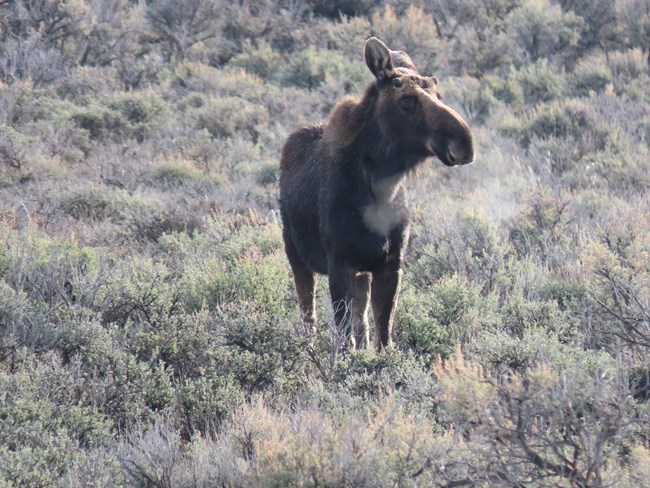
NPS/John Collins
Mammals
A list of mammal species of special concern includes fringed myotis (Myotis thysanodes), spotted bat (Euderma maculatum), Townsend’s big-eared bat (Corynorhinus townsendii), Idaho pocket gopher (Thomomys idahoensis), white-tailed prairie dog, Great Basin pocket mouse, pygmy rabbit, and mountain lion (Puma concolor). Some of these may not occur at the monument.
Birds
The avian species of management concern are golden eagle (Aquila chrysaetos) and sage grouse.
Amphibians
The northern leopard frog (Rana pipiens pipiens).
Second Priority Organisms
Many organisms on this list could potentially alter vegetation or imbalance predator–prey relationships. Others believed to have diminishing populations include moose, elk, pronghorn, beaver, badger, mule deer, bobcat, northern harrier, short-eared owl (Asio flammeus), black-billed magpie, mountain bluebird, prairie falcon, red-tailed hawk, Swainson’s hawk, ferruginous hawk, and American kestrel.
Last updated: June 30, 2025
